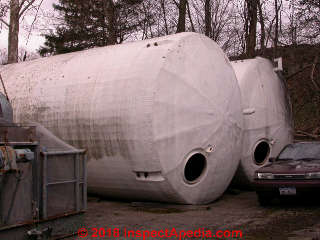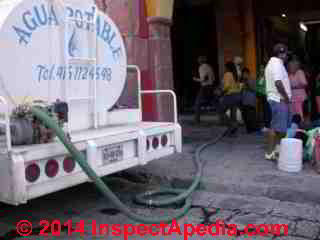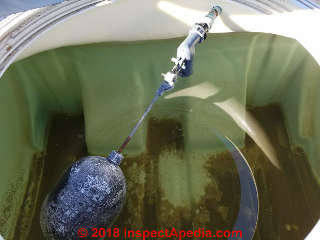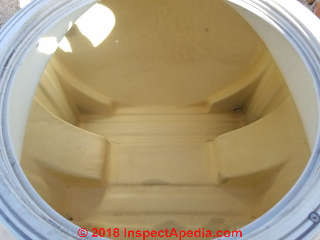 Water Tank, Cistern & Water Storage Tower Cleaning
Water Tank, Cistern & Water Storage Tower Cleaning
Procedures, codes, standards for cleaning or disinfecting cisterns, tanks, tank trucks
- POST a QUESTION or COMMENT about rooftop water tanks & cisterns
Water cistern, rooftop water tank, water tower-mounted & other water storage tank cleaning & disinfection procedures, codes, standards.
When, how-often, and how should a water storage tank, cistern,or water delivery truck be inspected, cleaned, and disinfected?
Topics discussed here:
What is the difference between cleaning a water storage cistern and disinfecting the cistern?
What safety precautions must be taken before entering a cistern to clean it?
This article series describes all types of cisterns and water storage tanks, including tower-mounted water storage tanks, where they are used, how they work, and the use of booster pumps to improve water pressure in buildings with rooftop water storage tanks. We include water storage design considerations, codes and standard references & citations. We also discuss using a booster pump to improve building water pressure in buildings with weak municipal water pressure or a weak rooftop.
Shown at page top, a rooftop water tower in Chicago. This tower illustrates a traditional woood-stave water tank design that has been in use for more than 100 years.
InspectAPedia tolerates no conflicts of interest. We have no relationship with advertisers, products, or services discussed at this website.
Water Tank / Cistern & Water Tank Truck Cleaning
Above: a rooftop plastic cistern used for water storage in central Mexico, shown before and after cleaning.
[Click to enlarge any image]
Water Tank Cleaning: all cisterns and water storage tanks require periodic cleaning and disinfection.
Typical standards or manufacturer advice requires emptying, cleaning, and if appropriate, disinfecting the tank either every six months (for example Alberta Canada) or every year (for example NY City) as well as following certain events.
We will review this requirementin more detail just below.
Difference between Water Storage Tank Cleaning & Water Storage Tank Disinfection
Water Storage Cistern or Tank Disinfection: a cistern or water storage tank that has no visible deposits of debris, mud, muck, can normally be flushed out and treated with a disinfectant to kill bacterial contaminants.
Key is to assure that the right concentration of bleach disinfectant is mixed in the cistern, and that the disinfectant is kept in the cistern as well as inside the pipes of the plumbing system that it supplies long enough for it be effective.
When there is no debris the cistern can be pumped empty or drained, then disinfected.
Normal household bleach (5% concentration or in some countries 8.35%) is mixed with water for disinfection. The bleach quantity depends on the cistern size and is discussed in detail below.
Water Storage Cistern or Tank Cleaning: if a cistern or water storage tank has visible muck or mud or other debris in the tank (normally on the tank bottom) that material needs to be physically removed.
Both of these procedures are described below.
When or How Often do Water Storage Tanks Need to be Cleaned / Disinfected?
 Regular Water Cistern Testing
Regular Water Cistern Testing
Water from a cistern should be sampled semi-annually for bacteriological quality.
If test results show the presence of coliform bacteria both the cistern and distribution system should be disinfected with chlorine2. - Source: Alberta DOH, CISTERN CLEANING [PDF] (2011) cited below.
The large storage tanks in our photo, observed in Highland New York, were used to store apple juice.
Time-Driven Water Cistern Cleaning: Annually or More-Often
6-12 Month Intervals: Cisterns should also be pumped clean and chlorinated at least once per year to prevent sludge build up or biological fouling.
This frequency may increase if water quality problems develop. Water testing and cistern cleaning should also follow any contamination incident (e.g. flooding, repairs) or following changes in water clarity, colour, odour or taste. - Source: Alberta DOH, Op. Cit.
Event-Driven Water Tank or Cistern Cleaning & Disinfection
A water storage tank or cistern should also be emptied and cleaned and disinfected following any of these events:
- Work on the water storage system: construction, repair or maintenance work on the cistern
- Flood Contamination: flooding in the area of an underground cistern or floodwaters or whenever any floodwaters or any other contaminated water source has entered the cistern or water storage tank
- Out of Use: after a period of non-use
- Bacteria contaminated: ampling which indicates the presence of bacteria - Source: MCWS,
WATER STORAGE TANKS (Cisterns) FACT SHEET [PDF], (2014) cited below.
Water Storage Tank / Cistern Cleaning & Disinfection Procedures
Watch out: Never enter a cistern unless you are properly trained in confined space entry. A cistern must not be entered until you are sure the cistern’s air quality is safe. No cistern should be entered unless the person entering follows the appropriate safety procedures. Do not work alone.
Be sure to review the detailed guidelines given by building and health authorities in your area regarding safe procedures for entering and working in and cleaning a cistern or any other enclosed space.
For example both the U.S. and Canada have written safety practices required for entering confined spaces. If you do not know how to do this work safely and are not properly trained you could be injured or killed. Hire a professional with the right training and qualifications.
Procedure for Cleaning a Water Storage Cistern or Tank
Physical cleaning will require the following steps:
- Store enough water to meet your needs during the 12 to 24 or more hours that will be needed to drain, clean, and re-fill the water storage cistern.
- Watch out: Assure that workers know safe practices for entering a confined space: otherwise do not permit the job to proceed.
- Drain: The water storage tank is drained completely
- Clean: Debris, sediment, mud and muck are shoveled or cleaned out into containers for removal if thick; remaining or lighter debris is removed by pressure-washing or brushing with a stiff brush.
Where a water-based cleaning solution is required, Wellcare® cited below recommends 1 cup of un-scented household bleach (5-8.25%) mixed in 10 gallons of clean water. In our opinion this would be a useful final step after all sludge and debris have been removed and surfaces appear clean. - Remove: Dirty water and debris that won't drain from the tank should be removed using a wet-type vacuum
- Rinse: Rinse out the cistern with clean potable water.
- Disinfect: Proceed to the water tank disinfection procedure described below.
What if the water cistern is not accessible for physical cleaning: the Alberta DOH document,
CISTERN CLEANING [PDF] cited in detail below offers a table of bleach dosage for water tanks of various sizes in order to obtain a disinfection solution of 50 ppm. of chlorine solution.
The tank is filled while mixing the sufficient amount of bleach, then left to sit, along with the same water in building piping, for 12 hours, then flushed out, the tank is drained, and re-filled with potable water.
1 cup of household bleach (5% chlorine) can treat 50 gallons of water.
For example, a 500 gallon water tank would require 500 / 50 = 10 cups of household bleach for treatment while a 1000 gallon water tank would need 1000 / 50 = 20 cups of bleach.
Procedure for Disinfecting a Cistern or Water Storage Tank
The steps to disinfect a water tank are pretty simple but if you don't already know the volume of your water tank or cistern you will need to make some measurements and use some simple math that we give below.
- Calcuate or Obtain the tank volume in gallons or liters
When you know the volume of the cistern or tank then you'll follow a formula we give below to follow three steps
- Add bleach to water: Add the proper amount of household bleach to a tank full of clean water, preferably as the cistern is being filled so that the disinfectant is well-mixed into the water.
The typical target concentration of bleach in water in the cistern is 10 mg/L to 20 mg/L of chlorine.
15 ml / 1 Tablespoon Bleach / 1 Gallon Water (Yukon Standard)
or
3 Cups of household Bleach (5-8.25%) / 100 U.S. Gallons (380 Liters) of Water
or
1/2 Litre of Bleach / 450 Litres (100 Imperial Gallons) of cistern water volume (Manitoba Standard)
or
1 L Bleach / 1000 Litres Water (Alberta Standard) For water tank or cistern disinfection use 1 Litre of Household Bleach for each 1000 Litres of water (the object is to have a concentration of 60 mg/L of chlorine)
or
1 U.S. Gallon of 12.5% chlorine bleach to a 10,000 gallon tank to obtain 10 mg/L concentration of chlorine. Double this amount to obtain a 20 mg/L concentration. (Los Angeles CA Standard)
2 U.S. Gallons of household bleach (5.25% chlorine bleach) to a 10,000 U.S. gallon tank to obtain 10 mg/L concentration of chlorine. Double this amount to obtain a 20 mg/L concentration. (Los Angeles CA Standard)
For water storage tanks of sizes other than 10,000 US Gallons, see California,
DISINFECTION of ONSITE WATER STORAGE TANKS [PDF] cited in more detail below.
Watch out: Use new, fresh bleach. Old bleach may have lost its strength and your disinfection procedure could fail.
Watch out: as several sources warn, never use an ammonia-based cleaner to clean a cistern as ammonia reacts with chlorine to produce a hazardous gas.
Watch out: if you send bleach solution into a water pressure tank or water heater (hot water cylinder, calorifier) you may have trouble flushing that solution out. You will have to completely drain the bleach solution from those tanks.
Be sure that the water heater has been turned OFF before any draining operation.
Note: Domestic or household bleach (sodium hypochlorite) is normnally sold at a 5% concentration of chlorine and at a pH of about 11.
Watch out: bleach can be hazardous to handle, risking burns to skin or eyes, particularly at higher concentrations.
Watch out: never mix ammonia with bleach or bleach solution. Doing so risks toxic chlorine gas. Mixing other chemicals such as acids and some organic compounds is also dangerous and can even produce explosive gases. In sum just use straight household bleach . - Wait 6 or more hours (Alberta Standard) or 2 hours or more (Yukon Standard):
Run sufficient water that the bleach solution is also able to disinfect building piping systems.
Watch out: Don't drink nor use the bleach water for laundry during this period .
With disinfectant in the water tank, wait at least six hours to allow sufficient disinfectant contact time, then empty the tank (where the chlorinated water won't harm anything), flush the tank with potable water, and refill it.
Waiting longer is usually not harmful. - Flush out the system: Flush the disinfected water out of the plumbing system and fixtures by running clean potable water through the plumbing system and fixtures for at least 5 minutes AND until you don't smell bleach.
Watch out: if there is mud, muck, debris inside the cistern, just bleach / disinfiectant is probably insufficient and the cistern needs to be physically cleaned and flushed out.
Watch out: some household bleach products are low-odor; you can't rely just on odor to determine if the system has been flushed of disinfectant.
Watch out: do not drink the highly-chlorinated disinfectant solution from the water tank: doing so is dangerous to humans or animals.
Watch out: do not dump highly-chlorinated water into a septic tank nor onto the drainfield: doing so can harm the septic system and contribute to its failure.
How to calculate how much water is in a cistern.
For a box cistern, multiply three numbers together to get cubic units of size, then convert those units to gallons using the numbers we give below
Multiply L x W x h
L = length of the rectangle
W = width of the rectangle
h = the height of the rectangle
For a cylindrical cistern, multiply three numbers together:
π x r² x h
where
π = 3.14, a constant
r² = radius (half the diameter of the circle)
h = height of the cylinder or in other words the depth of water.
Watch out: whether you are calculating the volume of a rectangular-shaped or box-shaped cistern OR a round or cylindrical cistern, be sure to keep all of your measurements in the same unit, for example inches or cm. Don't mix inches and feet without converting or your calculations will be wrong.
For odd-shaped cisterns you may need to obtain the volume contained therein from the manufacturer.
Conversion Factors to Change Inches, Feet, or CM to Gallons or Litres
- cc to L: To convert cubic centimers or cm or ccs to litres: measurements in cm divided by 1000 gives volume in litres
To convert cubic inches to cubic feet and then to gallons:
- cu. in. to cu. ft.: to convert cubic inches to cubic feet, divide the total cubic inches by 1728 to get cubic feet.
To convert cubic feet to gallons
- Cu.ft. to Imperial Gallons: Multiply cubic feet by 6.2 to get Imperial Gallons
- Cu. ft. to US Gallons: Multiply cubic feet by 7.5 to get U.S. gallons.
We discuss the calculation of water tank sizes in more detail
at WATER TANK SIZE & VOLUME.
Additional Cistern / Water Storage Tank Advice
- If the cistern is constructed from concrete, it may be desirable to use at least 3 loads of water prior to drinking the water. The water may still have a ‘chalky’ appearance and have a slight ‘cement taste’
The cistern should now be ready for use and can be refilled with potable water from an approved source.
- Restore power to the hot water system. Service any water treatment devices according to the supplier recommendations prior to bringing them back into service.
- Resample if cistern was disinfected due to a failed water test. If the lab report indicates the water is still unsafe, the cistern should be emptied and cleaned.
The Alberta DOH has these additional suggestions:
Adapted from this source: Alberta DOH,
CISTERN CLEANING [PDF] (2011) and other sources cited below.
Water Storage Tank & Tanker Truck Cleaning Guidelines, Codes, Standards

Photo: a water tank truck (a pipa) delivering potable water into an indoor cistern in San Miguel de Allende, Guanajuato, Mexico.
- CHLORINE HAZARDS in WATER
- CHLORINE in WATER, HOW TO TEST FOR
- CLEANING AND DISINFECTING A WATER HOLDING TANK [PDF] Yukon Department of Health & Social Service
- DISINFECTION OF ONSITE WATER STORAGE TANKS [PDF] California Department of Environmental Hygiene
- ROOFTOP WATER TANK CONSTRUCTION STANDARDS & REFERENCES below in this article where example codes and standards also address water tank inspection and cleaning
- Alberta DOH, CISTERN CLEANING [PDF] (2011) Alberta Canada Department of Health, retrieved 2018/09/11, original source: https://www.albertahealthservices.ca/Advisories/ne-pha-cistern-disinfection.pdf
Confined space entry for Alberta: See the Province of Alberta Occupational Health and Safety Code at www.whs.gov.ab.ca or call toll-free 1-866-415-8690. - California, DISINFECTION of ONSITE WATER STORAGE TANKS [PDF] Best Practices Fact Sheet, (2012) Los Angeles County Public Health, Environmental Health Division, Drinking Water Program,
5050 Commerce Drive Baldwin Park, CA 91706-1423 USA Tel (626) 430-5420 Email: waterquality@ph.lacounty.gov retrieved 2018/08/11 original source: http://publichealth.lacounty.gov/eh/docs/ep_dw_disinfection_tanks_fs.pdf - Clement, Bob, UNDERSTANDING the SIGNIFICANCE of BREACHES TO and SEDIMENT BUILDUP in FINISHED DRINKING WATER STORAGE TANKS [PDF], (2016) U.S. Environmental Protection Agency, EPA Region 8, [presentation]
- Godfrey, Sam & Bob Reed, WEDC, CLEANING & DISINFECTING WATER STORAGE TANKS & TANKERS [PDF] (2011) WHO, World Health Organization, and WEDC, Water Engineering and Development Centre, Loughboro University, Leicestershire LE 11 3TU UK, Tel: +44 1509 211079, Email: wedc@iboro.ac.uk Website: www.wedc.iboro.ac.uk retrieved 2018/09/11, original source: http://www.who.int/water_sanitation_health/publications/2011/tn3_cleaning_disinfecting_tanks_en.pdf
- MCWS, WATER STORAGE TANKS (Cisterns) FACT SHEET [PDF], (2014) Manitoba Conservation & Water Stewardship, retrieved 2018/09/11, original source: https://www.gov.mb.ca/waterstewardship/odw/public-info/fact_sheets/pdf/water_factsheet_cisterns.pdf
This document has detailed recommendations for cistern cleaning.
Excerpts:
Cisterns should be periodically cleaned and disinfected. Over time, the loss of chlorine residual can lead to microbial growth, sediments and sludge can accumulate in the cistern, or insects and debris may have fallen in.
NEVER ENTER A CISTERN UNLESS YOU ARE PROPERLY TRAINED IN CONFINED SPACE ENTRY.
Precautions and regulations related to confined space entry must be followed if entering a cistern. For more information regarding working in confined spaces, contact SAFE Manitoba (204-945-6848, www.safemanitoba.com).
- Norwesco, UNDERGROUND TANK INSTALLATION INSTRUCTIONS [PDF] Norwesco, Inc., 4365 Steiner Street / P.O. Box 439 St. Bonifacius, MN 55375-0439 USA, Tel: (800) 328-3420 Website www.norwesco.com
- US CDC CLEANING & DINSINFECTING WATER CISTERNS AFTER FLOODS & HEAVY RAINS [PDF] U.S. CDC
- Yukon DOH, CLEANING & DISINFECTING a WATER HOLDING TANK [PDF] Yukon Occupational Health and Safety, Yukon, Canada, Tel: (867) 667-5450 / 1-800-661-0408, ext. 5450. Retrieved 2018/09/11, original source: http://www.community.gov.yk.ca/pdf/cleaning_disinfecting_water_holding_tank.pdf
This article includes detailed advice and procedures regarding entering in confined spaces (such as the interior of a cistern or water storage tank for cleaning).
- (CSA) B126 Series-13 Water Cisterns, available from the Canadian Standards Association or CSA at https://store.csagroup.org/, retrieved 2018/09/11, original source: https://store.csagroup.org/ccrz__ProductDetails? viewState= DetailView&cartID=&sku= CAN/CSA-B126%20SERIES-13&isCSRFlow=true& portal User=&store=&cclcl=en_US&gclid= Cj0KCQ jwz93cBRCrARIsAEFbWshjpB4Qgr HuL5eMpmRiVwjbShi1gG- bMna-6U j8vP27a G9ACFRJGBQa Aqg6EALw_wcB
- Hobbs, Aubrey Thomas (ed.) 1969. Manual of British Water Engineering Practice . Vol 2. W. Heffer and Sons, Ltd: Cambridge, England
- OEE, WATER TREATMENT MANUAL: DISINFECTION [PDF], Office of Environmental Enforcement, ENVIRONMENTAL PROTECTION AGENCY An Ghníomhaireacht um Chaomhnú Comhshaoil PO Box 3000, Johnstown Castle, Co. Wexford, Ireland Telephone: + 353 53 9160600 Fax: + 353 53 9160699 Email: info@epa.ie Website: www.epa.ie , retrieved 2018/09/11, original source: https://www.epa.ie/pubs/advice/drinkingwater/Disinfection2_web.pdf
- OSHA, "Fall protection requirements for workers constructing a water tower while on a scaffold", US Department of Labor, OSHA, Standard 1926.451(g) and others, retrieved 4/15/14, original source https://www.osha.gov/pls/oshaweb/owadisp.show_document? p_table=INTERPRETATIONS&p_id=25047
- Rivera, Ray, Ruynyeon, Frank G., Buettner, Russ, "Inside City's Water Tanks, Layers of Neglect", The New York Times, 27 January 2014
- The New York Times, "E. Coli Found in Water Towers at NYC Buildings: Report
The city says the water towers are safe", The New York Times, 27 January 2014 - Excerpt
The city told the paper that its tanks -- the more than 10,000 of them currently in use -- are all safe and that health inspection standards are up to par.
Though dozens of New Yorkers have called 311 each year to complain they've gotten sick from drinking tap water, the city says none of the illnesses have been traced back to the tanks, according to the Times. - New York City Health Code Requirements for Cleaning Water Tanks:
NYC Department of Health and Mental Hygiene Office of Public Health Engineering Water Tank Inspection Reporting 42-09 28th Street, 14th Floor Long Island City, NY 11101-4132
Health Code provisions. Health Code Article 141 (“Drinking Water”) supports maintenance of the purity and sanitary condition of the City’s potable water supply. Health Code §141.07 regulates building drinking water storage tanks as follows:
§141.07 (b) requires that owners and other persons in control of buildings serviced by water storage tanks annually inspect the physical condition of tanks and sample tank water for bacteriological quality.
§141.07(c) requires written reports of these inspections to be maintained for at least five years, and provided to the Department within five business days of a request by the Department. As of January 1, 2015, documentation of the inspections must be submitted to the Department, indicating whether the results of the inspection were satisfactory.
§141.07(d) requires a building owner to post a notice in a building informing tenants how to obtain the results of inspections.
§141.07(e) requires owners to immediately correct any unsanitary conditions identified in the water tank inspections; to clean the tank when indicated in accordance with Health Code
§141.09; and to report any unsatisfactory findings in bacteriological sampling to the Department within 24 hours of receipt of such findings.
§141.07(f) provides that failure to submit reports to the Department when requested, or failure to submit the required annual documentation of an inspection, is prima facie evidence that no inspection was done at that time, and that separate violations may be issued for each year for which a required inspection report was not submitted.
§141.09 (“Building Water Tank Cleaning, Painting and Coating”) requires that when water storage tanks are cleaned, painted or coated, that work be done in accordance with industry standards, incorporating appropriate disinfection processes, by a duly qualified person or entity.
Department rules. In April 2015, the Department adopted a new Chapter 31 (“Drinking Water Tank Inspections”) of Title 24 RCNY. Section 31-02(a) of this new chapter requires building owners or their agents to report the results of the annual inspections of their drinking water storage tanks to the Department no later than January 15th of the following year. - https://www1.nyc.gov/assets/doh/downloads/pdf/notice/2016/noi-chapter31-title24.pdf retrieved 2018/07/31 - U.S. EPA FINISHED WATER STORAGE FACILITIES [PDF] (2002), U.S. Environmental Protection Agency, U.S. Environmental Protection Agency
Office of Ground Water and Drinking Water
Standards and Risk Management Division
1200 Pennsylvania Ave., NW
Washington DC 20004
Prepared by:
AWWA
With assistance from
Economic and Engineering Services, Inc retrieved 2018/09/11, original source: https://www.epa.gov/sites/production/files/2015-09/documents/2007_05_18_disinfection_tcr_whitepaper_tcr_storage.pdf
Introduction Excerpt:
The goal of this document is to review existing literature, research and information on the potential public health implications associated with covered storage reservoirs. - OH, DISINFECTION of a PUBLIC WATER SYSTEM WELL and DISTRIBUTION SYSTEM [PDF] (2017) Ohio Environmental Protection Agency, Division of Drinking and Ground Waters, P.O. Box 1049, Columbus, OH 43216-1049 USA, Tel: (614) 644-3020, retrieved 2018/09/11, original source: http://epa.ohio.gov/Portals/28/documents/rules/rtcr/DisinfectingWellandDistributionSystem.pdf
- U.S. EPA, CARING for a CISTERN [PDF] (2017), U.S. Environmental Protection Agency, by Wellcare®, a program of the Water Systems Council (WSC) retrieved 2018/09/11, original source: https://www.watersystemscouncil.org/download/wellcare_information_sheets/other_information_sheets/Caring-for-a-Cistern-FINAL.pdf
- "WAC 468-240-205 Obstruction lighting standards—Water towers, grain elevators, gas holders and similar obstructions.", Washington State Legislature, retrieved 4/15/14, original source: http://apps.leg.wa.gov/wac/default.aspx?cite=468-240-205
- "Water Tower", Princeton University, www.princeton.edu, retrieved 4/15/14, original source: https://www.princeton.edu/~achaney/tmve/wiki100k/docs/Water_tower.html also cited at Wikipedia below
- "Water Towers, Building Code, Design & Geologic Notes", water-towers.com, retrieved 4/15/14, original source: http://www.water-towers.com/WtrsCodeNote1.html
- WATER SOFTENER CLEANING & SANITIZING
- WATER TANK SIZE & VOLUME - calculate the tank volume to calculate the disinfectant needed
- WELL DISINFECTANT CHOICES
- WELL CHLORINATION & DISINFECTION - InspectApedia.com article series: disinfection procedure for water wells
Reader Comments & Q&A
Question:
I have a gravity water tank roof top on my house-Water is pumped up by the city when working ok-When the water (municipal) is not working I use the roof tank,
Generally what I do is shut the valve off at the street, then open the valve on the rooftop tank and it gravity feeds down into house.
The tank is located rooftop has 1 line going into the top of the tank for the inlet of water into the tank, the other lines is at the bottom that the water go's into the house..
Where would the check valve be located at? Best place to install it?
Will it interfere with the pressure if the water is only gravity with no pump?
Thank you,
James C. 6/27/2014
Reply:
I'd put the check valve on the tank side of the shutoff controlling water coming from the street main. In that location the check valve will not be between the tank serving as the building water source and the fixtures and piping that the tank serves.
...
Continue reading at ROOFTOP WATER TANKS or select a topic from the closely-related articles below, or see the complete ARTICLE INDEX.
Or see these
Recommended Articles
- LARGE CAPACITY WATER STORAGE TANKS
- WATER TOWERS
- WATER TESTING GUIDE - home
- WATER TREATMENT EQUIPMENT CHOICES
- WATER TANK SIZE & VOLUME
- WELL DISINFECTION PROCEDURE, POST FLOODING
Suggested citation for this web page
WATER TANK CLEANING CODES STANDARDS at InspectApedia.com - online encyclopedia of building & environmental inspection, testing, diagnosis, repair, & problem prevention advice.
Or see this
INDEX to RELATED ARTICLES: ARTICLE INDEX to WATER SUPPLY, PUMPS TANKS WELLS & SPRINGS
Or use the SEARCH BOX found below to Ask a Question or Search InspectApedia
Ask a Question or Search InspectApedia
Try the search box just below, or if you prefer, post a question or comment in the Comments box below and we will respond promptly.
Search the InspectApedia website
Note: appearance of your Comment below may be delayed: if your comment contains an image, photograph, web link, or text that looks to the software as if it might be a web link, your posting will appear after it has been approved by a moderator. Apologies for the delay.
Only one image can be added per comment but you can post as many comments, and therefore images, as you like.
You will not receive a notification when a response to your question has been posted.
Please bookmark this page to make it easy for you to check back for our response.
Our Comment Box is provided by Countable Web Productions countable.ca
Citations & References
In addition to any citations in the article above, a full list is available on request.
- Amtrol - AMTROL, Inc.,
Corporate Office,
1400 Division Road,
West Warwick, R.I. 02893
Tel: (401) 884-6300
Fax: (401) 884-4773 The company's website is at www.amtrol.com; also see Amtrol's installation and instruction manual for their Well-X-Trol water pressure control tank, a PDF file - Water Storage: Tanks, Cisterns, Aquifers, and Ponds for Domestic Supply, Fire and Emergency Use - -Includes How to Make Ferrocement Water Tanks, Art Ludwig, Oasis Design (May 30, 2005), ISBN-10: 0964343363, ISBN-13: 978-0964343368, Quoting:
A do-it-yourself guide to designing, building, and maintaining water tanks, cisterns and ponds, and sustainably managing groundwater storage. It will help you with your independent water system, fire protection, and disaster preparedness, at low cost and using principles of ecological design. Includes building instructions for several styles of ferro cement water tanks. - Thanks to aerospace engineer Herman Vogel, July 2010, for providing an update on High Density Polyethylene HDPE storage tanks for water, chemicals, waste oils, etc.
- Our recommended books about building & mechanical systems design, inspection, problem diagnosis, and repair, and about indoor environment and IAQ testing, diagnosis, and cleanup are at the InspectAPedia Bookstore. Also see our Book Reviews - InspectAPedia.
- In addition to citations & references found in this article, see the research citations given at the end of the related articles found at our suggested
CONTINUE READING or RECOMMENDED ARTICLES.
- Carson, Dunlop & Associates Ltd., 120 Carlton Street Suite 407, Toronto ON M5A 4K2. Tel: (416) 964-9415 1-800-268-7070 Email: info@carsondunlop.com. Alan Carson is a past president of ASHI, the American Society of Home Inspectors.
Thanks to Alan Carson and Bob Dunlop, for permission for InspectAPedia to use text excerpts from The HOME REFERENCE BOOK - the Encyclopedia of Homes and to use illustrations from The ILLUSTRATED HOME .
Carson Dunlop Associates provides extensive home inspection education and report writing material. In gratitude we provide links to tsome Carson Dunlop Associates products and services.



